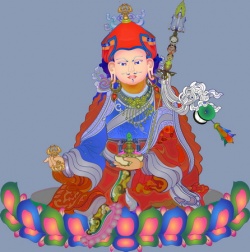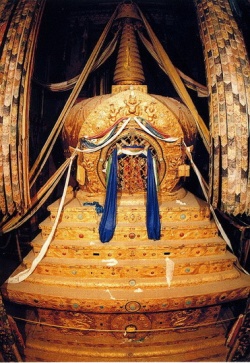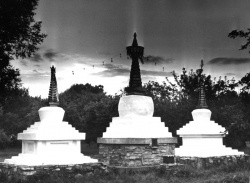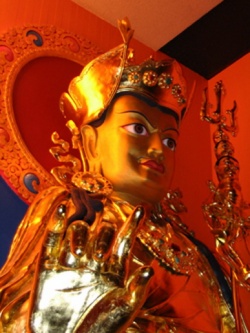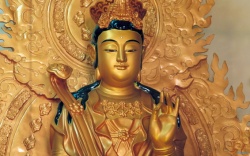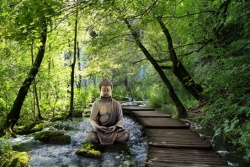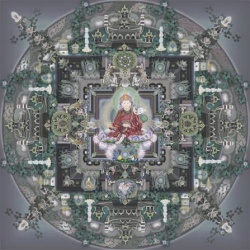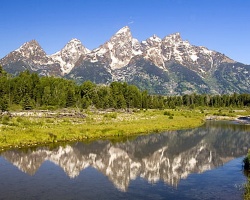The amplification of Buddhist monastic rules during rains-retreat (vassāvāsa)
Venerable BD Dipananda
When the rainy season has come and it is raining, many living beings are originated and many seed just spring up.....Knowing this one should not wander from village to village, but remain during the rainy season in one place -- Ᾱcārāṅga Sūtra. Jaina Sūtras -I,
136.p by H. Jacobi
This passage refers to the Jain mendicants’ practice during the Buddha's time in India; from whom the custom of rains-retreat was developed in Buddhism. During the rainy season the Jain mendicants developed the notion of non-injury (ahiṃsā) and paused their wandering
habits. Respecting this as well, the Buddha ordered his followers to pass the rainy season in settled dwellings.
The term 'vassāvāsa' means 'residence during rains'; also known as rains-retreat. Well known in the historical story, the Buddha preached his first sermon to the five ascetics at Sarnath. In those times, his preaching tour was reduced by the three month period spent
in vassāvāsa. However, as this practice was not yet a formal discipline, many monks continued to wander here and there. Two considerations worth mentioning about this rainy period are 1) the difficulties of travel in historical India, and 2) the potential harm to
living species. Paths were muddy, roads were covered with water, rivers overflowed – thereby restricting the movements of travelers. Secondly, when monks traveled during the rainy season, they potentially injured all forms of life including plants and creatures that
surfaced with the rains. People criticized the monks for this and thus the Buddha laid down the precept and enjoined the monks to enter a rains-retreat in a fixed location. The specific dates of the rains-retreat period vary somewhat: referring to the
earlier(purimikāin Pali) and later(pacchimikā) timing. The earlier period of rains-retreat spans from June- July(Ᾱsāḷha full moon) to September - October (full moon) of Buddhist lunar calendar. The later period begins one month after the earlier date: July-August
(Sāvaṇa full moon) to October-November full moon of Buddhist month. Each period is 3 out of 4 months in duration of the rainy season (according to Buddhist counting). For all monks and nuns it is compulsory to observe rains-retreat. However, according to Buddhist
discipline they are allowed to spend for seven days out of their residence for a few particular reasons. For example, to attend to the Buddhist Saṅgha, to give a Dhamma talk, or to visit relatives who have fallen ill. After the task or visit is completed, they should
return within seven days to their residence. It is also important to mention that if the location for retreat is vulnerable to danger from thieves or wild animals, then a monastic member is allowed to dispute the retreat without any offence of transgressing a rule of
discipline
During the rains-retreat, the monastic Saṅgha was advised to settle where alms-food and other requisites would be available without extensive travel. The retreat settlement is clearly defined in the Mahāvagga(The book of the discipline, Vol. iv, 51p. I.B.
Horner)stating: neither too far from a village nor too near, suitable for coming and going, accessible for people whenever they want, not crowded by day, having little noise at night, little sound, without folk's breath, haunts of privacy, suitable for seclusion.
For rains-retreat, two types of settlements were generally indicated in Buddhist monastic code: āvāsa-s and ārāma-s in Pali. The āvāsa-s were constructed by monks themselves as a monastic dwelling place made with natural boundaries such as a mountain, rock, tree and
so on, and that no one infringed upon another. These were temporary places set-up and at the end of the rains-retreat removed by monks. A specific chapter in the Mahavagga, Chapter- III (I.B. Horner) details the construction, maintenances, regulations, etc. for
these āvāsa-s. In contrast to the rather temporary āvāsa-s, the dwelling place of ārāma-s, was more permanent in nature, where a number of monks would dwell together. The word Saṅghārāma indicates a dwelling for the Buddhist Saṅgha and it is a monks’ private property
donated by lay devotees. Several donations of these ārāma-s are mentioned in the Tipitaka; one notable example being King Bimbisara's donation of Veluvana in Rajagriha. Symbolically, this gesture represented the first offering of its kind to the Buddhist Saṅgha. Later
developments of the ārāma-s became known as monasteries, or Buddhist temples, where large numbers of monks resided.
The significance and impact of the rains-retreat evolved from the early temporary locations called āvāsa-s. The ārāma-s, or more permanent dwellings, influenced the Buddhist Saṅgha in such a way that longer-term communities began to form and a collective life emerged
with numbers of monks living together in one place permanently. This idea was seeded originally with the institutionalization of rains-retreat. Additional structures like meeting halls, storerooms, bathrooms, kitchens, etc. became evident to the Buddhist Saṅgha to meet
their community needs. Rules and regulations for the management and administration of these communities developed as well. What began simply as 3-month pause in the practice routines of itinerant monks, institutional development occurred that would greatly influence
and benefit both lay and monastic cooperation. Additionally, the formalized rains-retreat would impact the monastic rules for practice and development of spiritual life.
Often in present day, the rains-retreat practice is not limited within the Buddhist Saṅgha, but lay followers can be found observing the period in Thailand, Myanmar, Sri Lanka and Bangladesh. During rains-retreat, lay followers take certain vows and observe the
precepts rigorously, engaging in activities such as: providing alms food to monastic Saṅgha, giving up smoking and intoxicants, observing the eight precepts, practicing meditation, chanting Buddhist Sutta-s and listening to Dhamma talks. At the end of the rains-
retreat the Buddhist Saṅgha performs a special ceremony called the pavāraṇā, where each one invites his fellows to point out any mistakes committed during the retreat period. It is well documented in the texts that during the rains-retreat, many monks and nuns
achieved spiritual goals. The rains-retreat affirms that both monastic and lay community have developed over time in mutual co-operation and observance of the Buddha’s teachings. Undoubtedly, with the institutionalization of the rains-retreat, the Buddhist Saṅgha has
performed an important role in the development of Buddhism.
Editor’s note: this article is the second in a series of three that explains more about the practice of rains-retreat (vassāvāsa), which is then followed by the Kathina ceremony.
The Buddhist monastic Saṅgha was not founded as the counterpart to the other sectarian traditions in the Buddha’s time, but rather it was an institution that evolved after gradual progress. The result of this progress, monastic rules and regulations were transmitted
due to sociological environments and its internal principle of evolution. Members of the Buddhist Saṅgha were commonly recruited from all ranks of society. Because of the varied cultural dimensions in the growing Saṅgha population, a critical consequence of the
differences generated a need for the communal life to be regulated within a framework of guidelines that everyone could adhere to.
The Buddhist idea of communal life, did not recommend living alone and companionless, but rather to settle in a congregation of monks. For that purpose, settlements quite naturally began and developed during the rains-retreat period. During rains-retreat, the societal
and cultural differences of the population living together became an important matter to resolve in order to live peacefully together. As the number of monks and nuns gradually grew in numbers, they sought accommodation in the residence. Initially, misunderstandings
and antagonism occurred between groups until everyone could find communion and harmony. For this reason and the sake of unity, the Buddha ordered the monastic Saṅgha to follow regulations, and also created the fortnightly celebration of the uposatha.
Uposatha is conducted on the eve of full moon and new moon days which marks special righteous days for the monastic members. Until today, it continues to be observed as the reciting of Pātimokkha, a record of rules governing the behavior of the Buddhist Saṅgha. The
uposatha was enjoined for monastic Saṅgha to indicate more advanced practice in monastic life. The purpose of this celebration is a custom of the Buddhist Saṅgha who live in a permanent community and it allows them to engage in a form of communal activity among
themselves. Another significance of the celebration of uposatha is the extensive bliss shared in development of monastic life. This is a communal activity and monastic members are not allowed to hold separate recitation of the Pātimokkha in their private compartments.
They have to come together in a separate cell known as the observance hall, and the recitation is held in the presence of all monastic Saṅgha who live within the boundaries of the residence. This rule demonstrates the important spirit of cooperation within the
community. These early rules and rituals of moral responsibility eventually evolved into the Vinaya Pitaka which governs the relationship of a monastic member within their community.
In order to recite the Pātimokkha and carry out other uposatha duties, the presence of a minimum of four monks is required. In the case when three monastics are present, there will be a different system. A senior monk will lead a discussion on individual purity based
on one of the Vinaya codes. Each in turn will reflect and share on their purity of that particular issue. In a similar manner, if two monastics are present, based on their seniority, a purity review will ensue. For a single monk living alone in residence, on the
uposatha day, he will personally reflect and make the determination within himself: today is my uposatha and practice awareness of the precepts with dedicated vigilance. According to tradition, Buddhist nuns also observe the uposatha but the distinguishing feature is
that every half month they must enquire from the monks the precise date of the uposatha as part of their protocol.
The uniqueness of the uposatha is that it is not just limited to practice within a Buddhist monastic Saṅgha. Householders may also observe the day. In lay life, they may observe the uposatha on additional days to include: full moon day, new moon day, eighth day (two
quarter moons of each month) and some other special days in the culture. On these days, they accept the eight precepts known as uposatha sīla in Pali, when they abstain from injuring life, theft, sex, lying, intoxicants, refrain from having solid food in improper
time, refrain from dancing, singing, wearing garland, perfumes and refrain from lying on a luxuries sleeping place (eighth precept). By undertaking these precepts, lay followers also practice meditation; listen to Dhamma talks and so on. During the rains-retreat, the
lay followers diligently observe each and every uposatha ceremony. In present day, Theravada Buddhists, mostly found in Thailand, Myanmar, Sri-Lanka, Bangladesh, observe the uposatha day with other ritual activities. One illustration of this type of other activity is
shared below in personal experience:
Several years back, the usual procedure of uposatha was observed at a monastery in Kolkata, India by the monastic members and lay followers. In this instance, the starting date was an earlier one (purimikā in Pali) as the rains-retreat followed by Ᾱsāḷha full moon
day. According to Buddhist history, the Buddha preached first sermon known as Dhammacakkhappavattana Sutta (setting the wheel of Dhamma in motion) on the Ᾱsāḷha full moon day. Many of the lay followers came to the temple on the special day dressed in white clothing and
worshiped to the Buddha and Saṅgha monks as per normal tradition. Three Buddhist monks, including me, were presented and in front of us lay devotees were seated on mats spread on the floor. At first they accepted the five precepts. However, many of the people adopted
the eight precepts in part of the ceremony conducted by a senior monk who spoke in Pali. Everyone continued with a long period of chanting, paid homage to the Buddha, Dhamma and Saṅgha, and then made offerings of food, flowers, incense, lamps etc. All of us shared the
accumulating merits to relatives, friends, family members and all sentient beings. The session concluded a short time before noon by the monks who drew attention to the devotees on the significant of the precepts. All devotees offered foods to the monks and those who
adopted the eight precepts, ate their lunch in accordance with the timing of the monastic members. Later on, people who had attended the ceremony, had their lunch and offered to their relatives. After having lunch, there was a choice to stay in the monastery for an
afternoon Dhamma talk, engage in discussion, read Dhamma books or practice meditation. Otherwise, one could go home as well.
In the evening, other people joined the group that undertook five precepts and engaged in evening chanting which concluded the uposatha ceremony. One variation worth mentioning was that when I was a lay Buddhist in my village in Bangladesh, we kept the eight precepts
until the next morning, thus continuing the uposatha until the next day. In the next morning all of us (who had adopted the eight precepts) returned to the monastery, gave up the eight precepts, and re-accepted the five precepts from the monastery monks. We did not
have solid food in the afternoon (except for some juices) during the uposatha day as per normal Theravada tradition. Those who accepted the eight precepts were treated as holy men, and people who offered them juice and foods accumulated more merits when donating to
this group.
During my time as a novice monk, when certain householders were physically challenged and unable to come to the temple, we went to their homes and honored their request to take the eight precepts. During the uposatha days, if a person is not closely affiliated with a local monastery, he or she can observe the uposatha day by undertaking the eight precepts in front of a Buddha image. According to this practice of privately taking precept vows, we can easily say that millions of people are practicing Buddhism around the world in a manner that is not necessarily visible in public.
The three-month rains-retreat seclusion of Buddhist Saṅgha concludes with the pavāraṇā (invitation) ceremony, which is in turn followed by Kaṭhina robe offering festival. It is a traditional ceremony and ancient custom mostly found in the Theravada Buddhist tradition. Today, the Kaṭhina robe offering is a large, annual festival where Buddhists get together and celebrate the day by offering monastics gifts, such as robes and alms.
Kaṭhina means “hard”, “stiff”, “difficult”, etc. The word Kaṭhina denotes a cloth offered to the monks annually after the end of the rains-retreat (vassāvāsa). It also refers to a wooden frame used by the monks in sewing their robes. However, the word mostly denotes the robe, cīvara in pali, known as Kaṭhina cīvara. The character of the material used symbolizes the cīvara, which is one of the four requisites of a monk. The Kaṭhina robe is offered to the monastic Saṅgha by lay followers. Apart from the lay followers, monks, nuns and novices also can offer to the Buddhist Saṅgha.
The historical background of the Kaṭhina robe offering is mentioned in the Vinaya Pitaka. While the Buddha was dwelling at JetavanaVihar in Shravasti, a group of thirty monks visited the Buddha after the three-month rains-retreat. The Buddha asked them about their retreat and noticed their worn out robes. It is said that at the time, monks used to wear sewn pieces of cloth collected from different places such as cemeteries, streets, rubbish-heaps, etc.To rectify this, the Buddha granted permission to celebrate the Kaṭhina ceremony with the following such rules:
· - Only those who have successfully completed the rains-retreat can accept the Kaṭhina robe.
· - The period of the offering is only one month, from the middle of September-October to October-November (lunar month), and contemporary Assayuja to Kattikā (full moon of the Buddhist month).
· - When the Kaṭhina robe is offered to the Buddhist Saṅgha by lay followers, a group of monks (not less than four monks) will officially hand over to a selected monk by performing some Buddhist ritual activities (Vinaya rules).
· - A monk who has received the Kaṭhina robe is not allowed to receive the Kaṭhina robe a second time in the same month period.
· - Whoever observes rains-retreat from the later (pacchimikā) time, also not allowed to receive the Kaṭhina robe. Only those who have entered the rains-retreat from the earlier (purimikā) time, are allowed to receive it.
· The proper time to give the Kaṭhina robe is from sunrise to dawn the next day, and in modern time it is calculated as twenty-four hours.
The monk who accepts the Kaṭhina robe enjoys five privileges. From the date of the ceremony, (i) he is free to go to a meal invitation without having informed another monk. (ii) Usually monks use a full set of three robes, but he is allowed to go without taking a full set robes according to a specific period of time without any fault. (iii) He can enjoy a group meal (with four or more monks). (iv) He can use as many as robes as he likes (v). Finally, he can receive other robes offered to the Buddhist Saṅgha during the period of rainy season and on the occasion of the Kaṭhina ceremony.
The Buddha himself stated the significance of the offering of Kaṭhina robes in the Vinaya Piṭaka. In the Mahāvagga, it is stated that the Kaṭhina robe offering is the highest offering and the most meritorious of skillful deeds. The immeasurable merits of offering the Kaṭhina robe can be illustrated in many examples. In a previous life, the Venerable Nāgita Thera offered the Kaṭhina robe to the Saṅgha. As a result of accumulated merits, he enjoyed divine pleasures and reigned as the king of heaven for many eons. He never suffered in the unpleasant planes and in his last birth he became an Arahant (a worthy one), during the Buddha's era.
Today, the Kaṭhina robe offering ceremony is celebrated as the largest festival among traditional Buddhists in the world. Throughout the day, Buddhists enjoy the ceremony with cultural entertainment and performing many meritorious acts. According the schedule, it begins early in the morning. People gather in the monastery, undertake the five precepts, and listen to Dhamma talks. The first session is concluded before noon. Thereafter, the devotees serve a meal to the Saṅgha and enjoys whatever is left over. The main theme of Kaṭhina begins at midday, around 13:00, where many monks give Dhamma talks and talk about the significance of the Kaṭhina robe offering. A representative of the laypeople leads the ceremony and announces the offering. After receiving the robes, monks do other activities and perform some Vinaya rules. At the ending session, the festival is concluded by sharing the accumulated merits to relatives and sentient beings. In the evening, the people perform some cultural programs such as singing Buddhist songs and traditional dancing. It is important to mention that, in this present day and age, people offer ready-made robes to the Saṅgha for the Kaṭhina robe. In contrast to this, some monasteries' devotees in Bangladesh offer handmade Kaṭhina robes. Within the Kaṭhina day, a group of people scratches the fibers, cut the threads and make the cloth. After sewing the robe, it is dyed and made a suitable color, and the resulting robe is offered to the Saṅgha.
The meaning of Kaṭhina cīvara is associated with a number of Buddhist rules and regulations. For example, monks observe the rains-retreat for three months. At the end of the rains-retreat, they perform the pavāraṇā (invitation), and after the rains-retreat the Kaṭhina robe offering ceremony takes place annually for one month by performing Vinaya activities. That is why the Kaṭhina ceremony demands more determination, firmness and stability, and the sponsors, receivers, and makers accumulate immeasurable merits. The ceremony is far more special than other offerings. It is the most important and beneficial skillful deed that cultivates all that is good within us. And from that, we gain all the blessings toward the highest goal known as Nibbāna.
